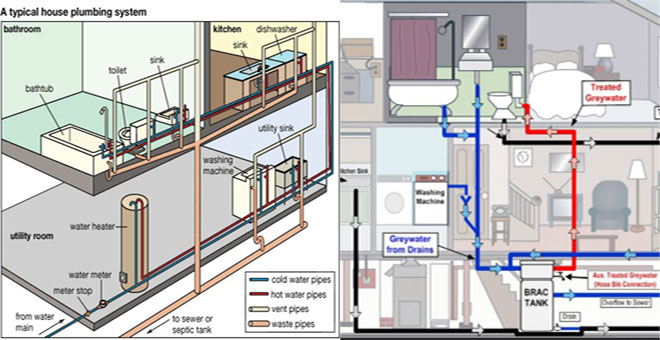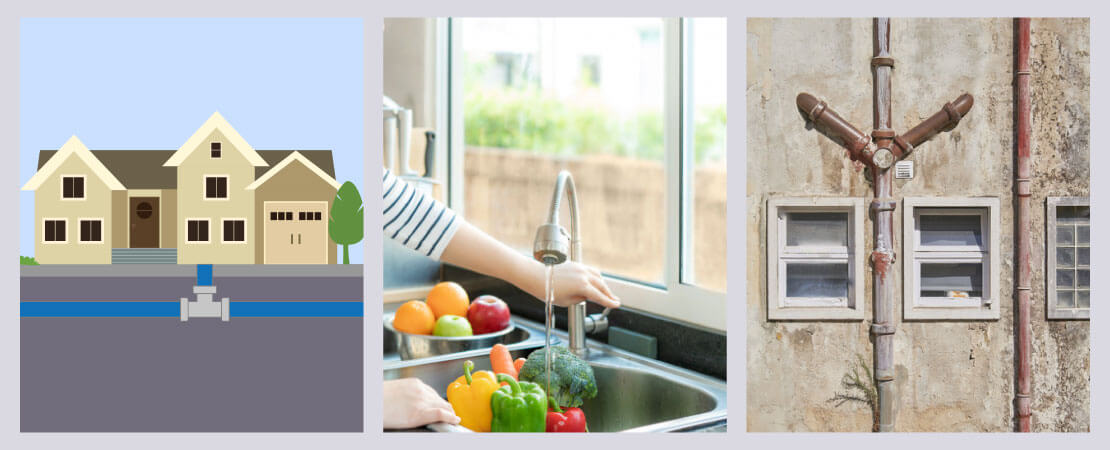They are making several good points on the subject of Exploring Your Homes Plumbing Anatomy overall in the article following next.

Understanding how your home's plumbing system works is essential for every property owner. From providing clean water for drinking, cooking, and bathing to securely getting rid of wastewater, a properly maintained pipes system is vital for your household's health and wellness and comfort. In this comprehensive guide, we'll discover the complex network that comprises your home's plumbing and offer tips on upkeep, upgrades, and managing typical problems.
Introduction
Your home's pipes system is greater than just a network of pipes; it's a complex system that guarantees you have accessibility to clean water and effective wastewater removal. Recognizing its elements and how they collaborate can help you protect against expensive repairs and guarantee everything runs efficiently.
Fundamental Parts of a Pipes System
Pipelines and Tubing
At the heart of your plumbing system are the pipelines and tubing that bring water throughout your home. These can be made of numerous products such as copper, PVC, or PEX, each with its advantages in regards to toughness and cost-effectiveness.
Fixtures: Sinks, Toilets, Showers, and so on.
Fixtures like sinks, commodes, showers, and bathtubs are where water is made use of in your home. Comprehending how these fixtures attach to the plumbing system aids in diagnosing problems and planning upgrades.
Shutoffs and Shut-off Points
Shutoffs manage the circulation of water in your pipes system. Shut-off shutoffs are vital during emergency situations or when you need to make repairs, enabling you to isolate parts of the system without disrupting water flow to the whole residence.
Supply Of Water System
Key Water Line
The major water line connects your home to the community water or a private well. It's where water enters your home and is distributed to numerous components.
Water Meter and Stress Regulator
The water meter actions your water usage, while a stress regulator makes sure that water flows at a risk-free pressure throughout your home's plumbing system, protecting against damage to pipelines and fixtures.
Cold Water vs. Warm water Lines
Recognizing the distinction in between cold water lines, which provide water directly from the main, and hot water lines, which bring warmed water from the hot water heater, helps in fixing and preparing for upgrades.
Drain System
Drain Pipes Piping and Traps
Drain pipelines carry wastewater far from sinks, showers, and commodes to the sewer or sewage-disposal tank. Catches avoid drain gases from entering your home and additionally trap debris that can cause blockages.
Air flow Pipelines
Ventilation pipes allow air into the water drainage system, preventing suction that might reduce water drainage and cause traps to vacant. Appropriate air flow is essential for preserving the stability of your pipes system.
Importance of Proper Drain
Making sure appropriate drain stops back-ups and water damages. On a regular basis cleaning up drains and maintaining catches can protect against expensive repair services and expand the life of your pipes system.
Water Heating System
Sorts Of Water Heaters
Water heaters can be tankless or conventional tank-style. Tankless heating units heat water on demand, while containers save warmed water for instant use.
Upgrading Your Plumbing System
Factors for Updating
Upgrading to water-efficient fixtures or replacing old pipes can enhance water high quality, minimize water expenses, and boost the worth of your home.
Modern Pipes Technologies and Their Advantages
Check out innovations like wise leakage detectors, water-saving bathrooms, and energy-efficient hot water heater that can save money and lower ecological effect.
Cost Considerations and ROI
Compute the in advance expenses versus long-term financial savings when thinking about pipes upgrades. Several upgrades spend for themselves via minimized energy expenses and fewer repairs.
How Water Heaters Attach to the Pipes System
Recognizing exactly how water heaters connect to both the cold water supply and hot water circulation lines aids in identifying issues like not enough warm water or leaks.
Upkeep Tips for Water Heaters
Frequently flushing your hot water heater to eliminate debris, inspecting the temperature level settings, and inspecting for leakages can expand its life-span and improve power performance.
Typical Plumbing Concerns
Leakages and Their Reasons
Leaks can occur as a result of maturing pipes, loosened installations, or high water pressure. Resolving leakages quickly protects against water damage and mold and mildew growth.
Obstructions and Clogs
Blockages in drains pipes and bathrooms are frequently caused by purging non-flushable items or a buildup of grease and hair. Utilizing drainpipe displays and being mindful of what drops your drains can avoid obstructions.
Indications of Plumbing Troubles to Look For
Low tide stress, sluggish drains, foul odors, or abnormally high water bills are signs of potential pipes problems that need to be dealt with promptly.
Pipes Maintenance Tips
Routine Inspections and Checks
Set up annual pipes evaluations to capture problems early. Search for indicators of leaks, deterioration, or mineral buildup in taps and showerheads.
DIY Upkeep Tasks
Simple tasks like cleansing faucet aerators, looking for toilet leakages making use of dye tablet computers, or insulating subjected pipelines in cold climates can protect against major pipes issues.
When to Call an Expert Plumbing Technician
Know when a plumbing issue needs expert experience. Attempting complex repair work without appropriate expertise can bring about even more damages and greater repair expenses.
Tips for Lowering Water Usage
Easy routines like fixing leaks quickly, taking shorter showers, and running full tons of washing and recipes can preserve water and reduced your energy costs.
Eco-Friendly Pipes Options
Take into consideration lasting pipes products like bamboo for flooring, which is durable and environmentally friendly, or recycled glass for kitchen counters.
Emergency situation Preparedness
Steps to Take During a Pipes Emergency situation
Know where your shut-off shutoffs lie and how to shut off the water system in case of a ruptured pipeline or significant leak.
Relevance of Having Emergency Situation Calls Convenient
Maintain call info for regional plumbing technicians or emergency situation solutions readily available for quick response during a plumbing dilemma.
Environmental Effect and Preservation
Water-Saving Components and Devices
Mounting low-flow faucets, showerheads, and commodes can dramatically reduce water use without compromising efficiency.
Do It Yourself Emergency Situation Fixes (When Suitable).
Momentary repairs like utilizing air duct tape to spot a leaking pipe or putting a container under a dripping tap can lessen damage until a specialist plumbing technician shows up.
Conclusion.
Recognizing the composition of your home's pipes system encourages you to keep it successfully, saving time and money on repair work. By following regular upkeep regimens and staying educated regarding modern pipes innovations, you can ensure your pipes system operates successfully for many years ahead.
Understanding Your Home Plumbing System: A Comprehensive Guide
Plumbing System: The Lifeline of Your Home
At its core, the plumbing system is designed to perform two primary functions: bring fresh water into your home and remove wastewater. The system is a network of pipes, fixtures, and other components that transport water and sewage. Residential plumbing systems include potable water supply lines, drain-waste-vent (DWV) systems, and various plumbing fixtures that make water use in daily tasks possible.
Key Components:
Water Supply: This part of your plumbing system brings municipal water into your home, passing through the main water supply line. It s responsible for supplying all water needs, from drinking to bathing.
Drainage System: It carries waste and water away from your home to the sewer or septic system. This system includes all the piping within your home that leads to external sewage or septic systems.
Vent System: An essential yet often overlooked component, the vent system allows sewer gases to escape and lets air into the drainpipes, ensuring water and waste move correctly through the system.
Fixture: More Than Just Taps and Toilets
Plumbing fixtures are the most interactive parts of the plumbing system, including faucets, showers, toilets, and sinks. Each fixture is connected to the plumbing system and plays a role in either the delivery of freshwater or the disposal of waste and wastewater.
Types of Fixtures:
- Faucets and Sinks: Used for washing hands, dishes, and other daily water needs.
- Toilets: Dispose of human waste through the sewage system.
- Bathtubs and Showers: Provide bathing facilities, requiring both hot and cold water supply.
Water Supply: The Source of Life
The water supply system is a critical component, ensuring that potable water is available throughout your home for various uses, including drinking, cooking, and cleaning. This system consists of pipes that distribute water to different parts of the house, controlled by valves to regulate the water flow.
Types of Plumbing: Materials and Methods
Various types of plumbing systems and materials are used in residential settings, each with its advantages and applications. From copper and PVC pipes for water supply to cast iron and ABS for drainage, the choice of materials can impact the longevity and efficiency of your plumbing system.
https://intownplumbingtx.com/articles/home-plumbing-system-guide/

I'm very intrigued by and I'm hoping you liked our blog posting. Loved our blog entry? Please quickly share it. Let another person check it out. I love reading our article about Anatomy of a House: Understanding the Components.
Visit My Web Page
Comments on “What You Need to Know About Your House's Plumbing System Anatomy”